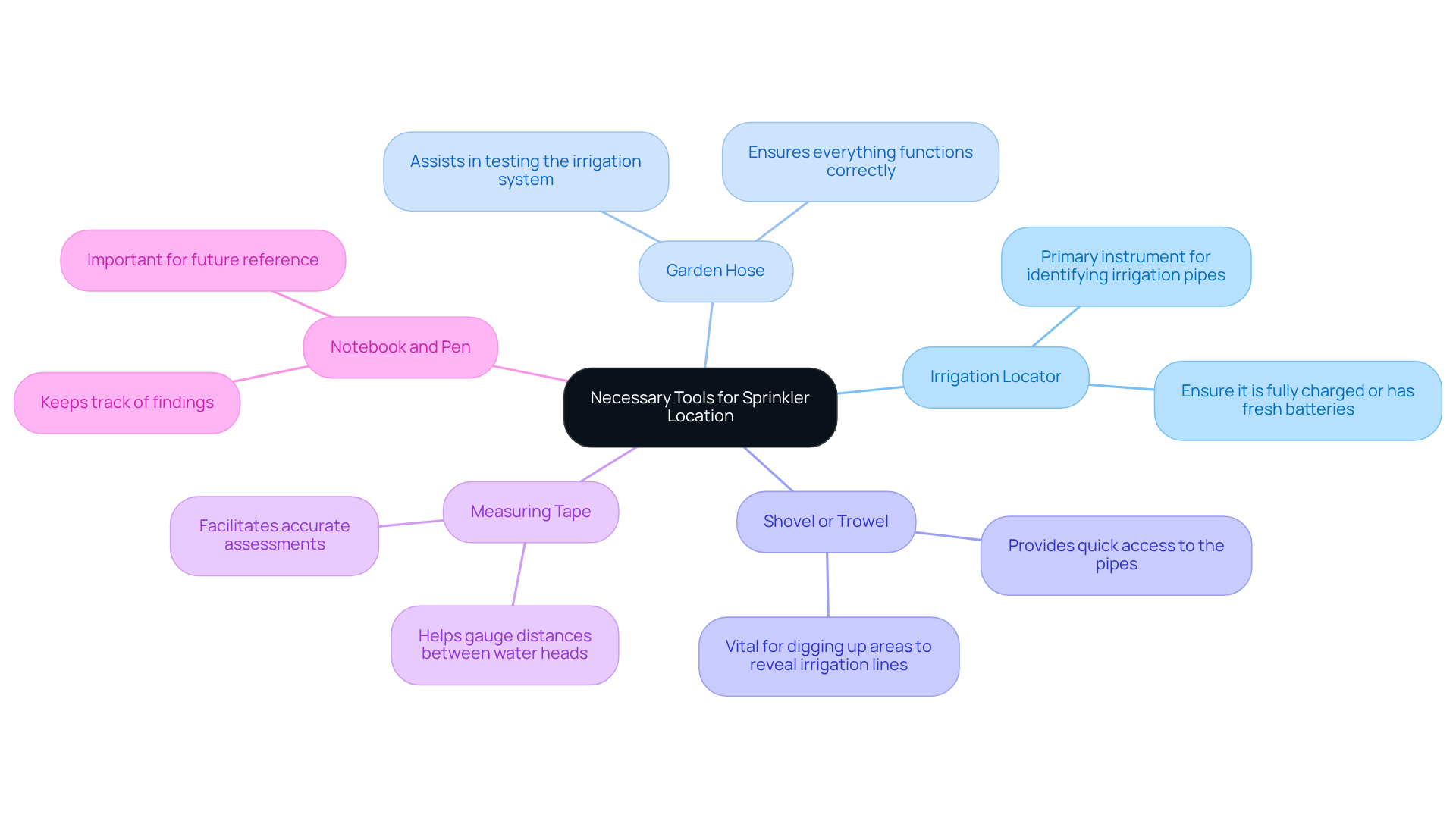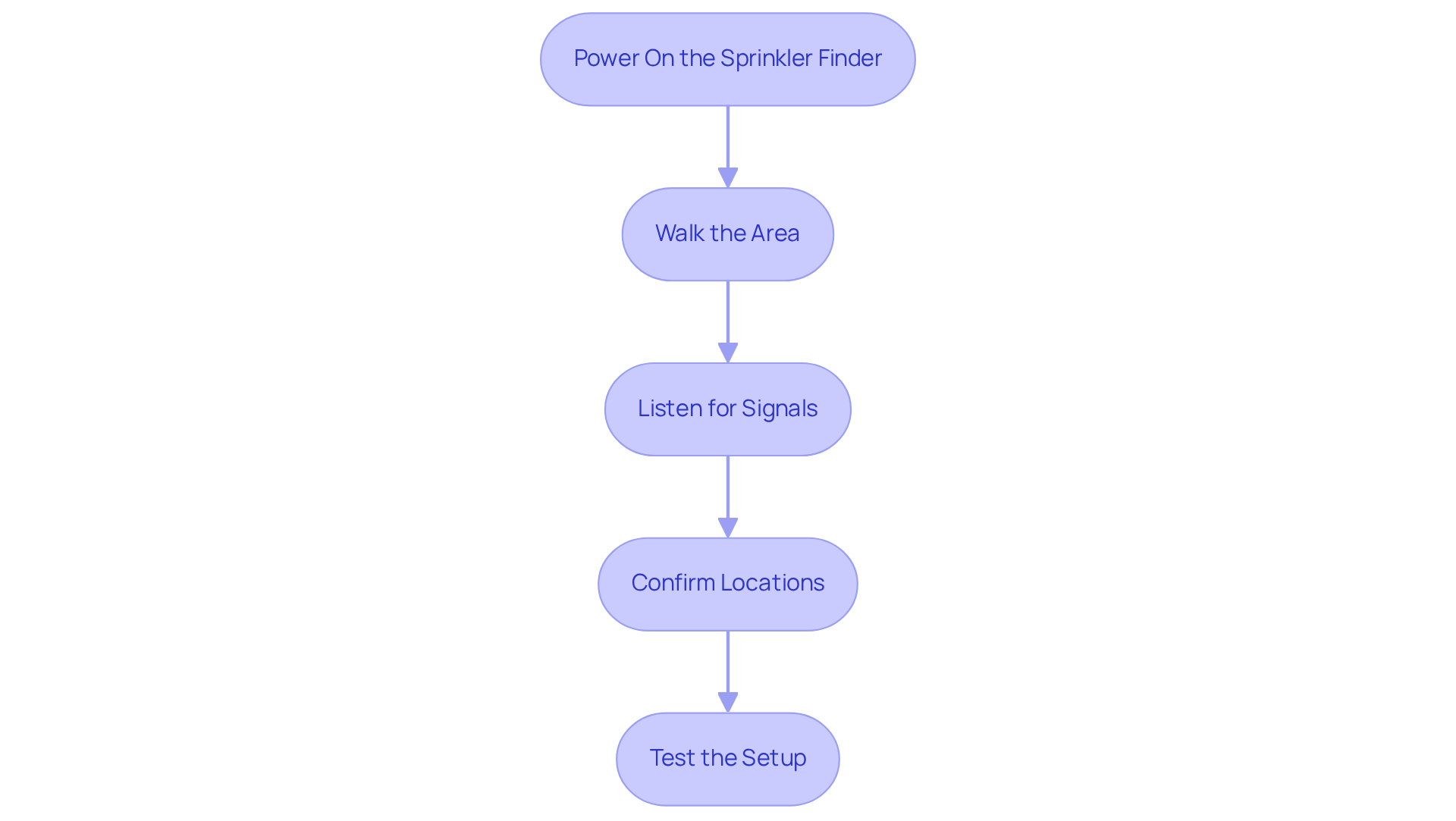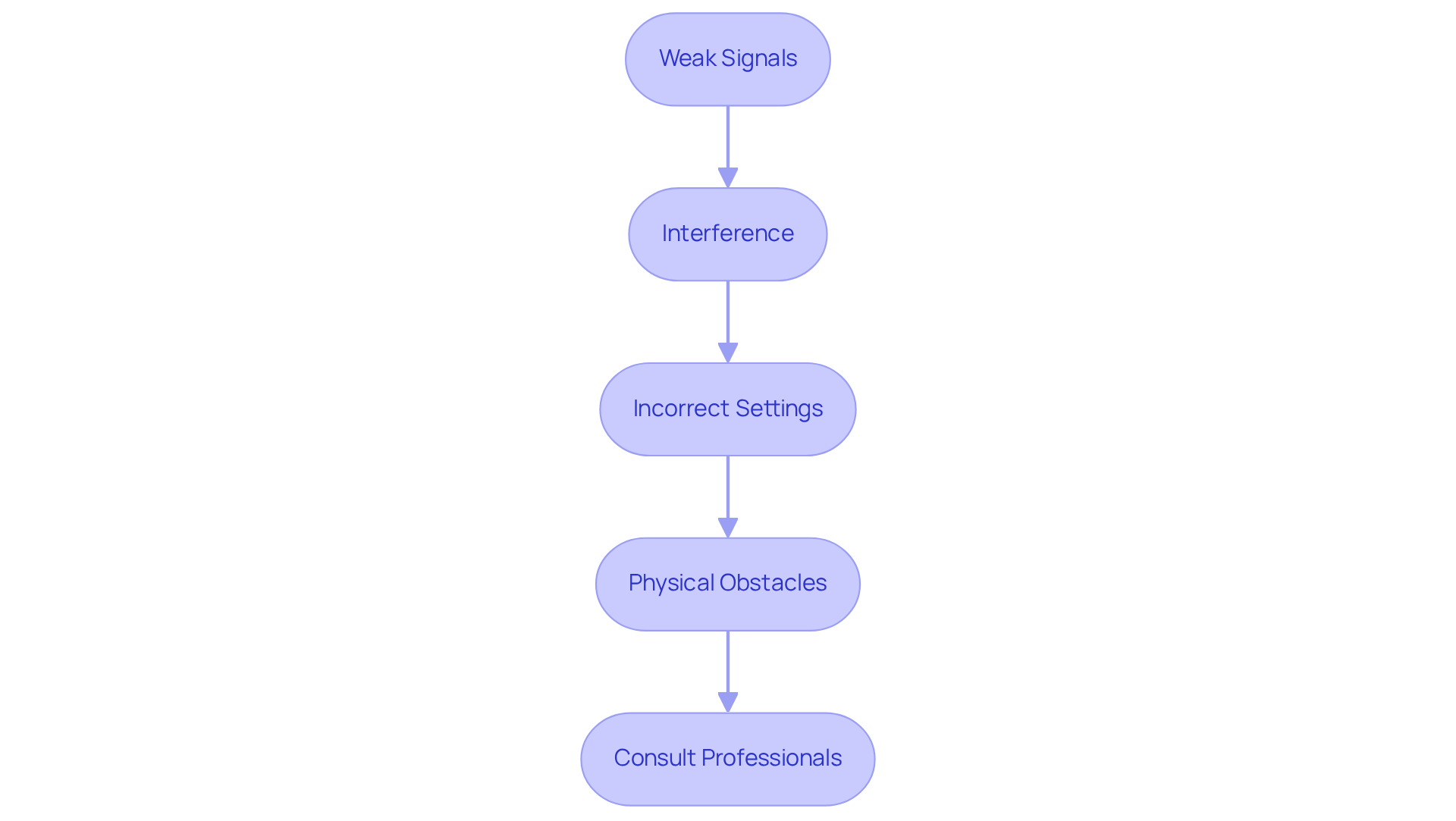Overview
To effectively utilize a sprinkler finder, one must first gather essential tools, power on the device, and methodically search the area while attentively listening for signals that indicate the presence of irrigation lines. This process not only ensures the successful location of sprinkler systems but also verifies their functionality.
The article provides a comprehensive step-by-step guide, complete with troubleshooting tips, empowering users to navigate potential issues that may arise during their search. By following these guidelines, users can confidently engage with their sprinkler systems, ensuring optimal performance and reliability.
Key Highlights:
- Gather essential tools for locating sprinklers: irrigation locator, garden hose, shovel/trowel, measuring tape, notebook, and pen.
- Power on the sprinkler finder and set it to detect underground utilities.
- Walk the area in a grid layout, keeping the locator close to the ground, and listen for signals indicating irrigation lines.
- Mark potential irrigation locations with flags or chalk and confirm distances using a measuring tape.
- Test the irrigation system with a garden hose to ensure proper functionality.
- Troubleshoot weak signals by checking battery levels and settings, and avoid interference from metal objects.
- If issues persist, consult professionals for assistance with locating your sprinkler system.
Introduction
Locating underground sprinklers can often feel like searching for a needle in a haystack, particularly when the layout of your yard remains a mystery. However, with the right tools and a systematic approach, this seemingly daunting task can be transformed into a straightforward process. This guide presents a clear, step-by-step method to effectively utilize a sprinkler finder, ensuring that every corner of your irrigation system is accounted for.
Furthermore, what should you do when the signals aren’t as clear as expected, or when obstacles arise during the search? Discover how to navigate these challenges and ensure your watering system operates flawlessly.
Gather Necessary Tools for Sprinkler Location
Before you begin using a sprinkler finder to locate your sprinklers, it is essential to gather the necessary tools to ensure an efficient process. Here’s what you need:
- Irrigation Locator: This is the primary instrument you will utilize to identify the position of subterranean irrigation pipes. Ensure it is fully charged or equipped with fresh batteries for optimal performance.
- Garden Hose: A standard garden hose can assist you in testing the irrigation system once you locate the pipes, ensuring everything functions correctly.
- Shovel or Trowel: In the event you need to dig up any areas to reveal the irrigation lines, having a shovel or trowel readily available is vital for quick access.
- Measuring Tape: This tool will help you gauge distances between water heads and other points of interest in your yard, facilitating accurate assessments.
- Notebook and Pen: Keeping track of your findings and any notes about the arrangement of your irrigation system is crucial for future reference.
Having these tools prepared simplifies the process and significantly enhances your ability to efficiently use a sprinkler finder to locate your irrigation systems. By ensuring you are equipped with the right instruments, you position yourself for success in managing your irrigation needs.

Follow Step-by-Step Instructions to Use the Sprinkler Finder
To effectively utilize your sprinkler finder, adhere to the following steps:
- Power On the Sprinkler Finder: Activate the device and ensure it is set to the appropriate mode for detecting underground utilities. Consult the user manual for specific settings that optimize performance.
- Walk the Area: Methodically stroll around the area where you suspect the irrigation lines are located. Keep the water source locator close to the ground, moving in a grid layout to cover the entire region thoroughly.
- Listen for Signals: The sprinkler finder helps locate irrigation systems efficiently. As you proceed, pay attention to beeping or visual signals emitted by the finder. These signals indicate the presence of underground irrigation lines. Mark these locations with flags or chalk for easy identification.
- Confirm Locations: After marking potential irrigation points, utilize your measuring tape to confirm distances from known landmarks, such as trees or fences, ensuring accuracy in your findings.
- Test the Setup: Once you have located the irrigation devices, attach your garden hose and activate the mechanism to verify that the watering equipment is functioning correctly. Adjust any settings as necessary to enhance performance.
By following these steps, you will effectively locate and verify the functionality of your irrigation system, ensuring reliable operation for your landscaping needs.

Troubleshoot Common Issues When Locating Sprinklers
If you encounter issues while locating your sprinklers, consider these essential troubleshooting tips:
- Weak Signals: If the irrigation detector is not recognizing signals, check the battery level and replace it if necessary. Ensure the device is set to the correct mode.
- Interference: Nearby metal objects or other underground utilities can disrupt the device's signals. Move away from these areas and try again.
- Incorrect Settings: Double-check that the irrigation locator is configured to the suitable frequency for detecting your specific watering setup. Refer to the user manual for guidance.
- Physical Obstacles: If you are unable to locate the irrigation systems due to hard ground or landscaping features, use your shovel or trowel to gently dig around the suspected areas to expose the lines.
- Consult Professionals: If you continue to have difficulties, consider reaching out to a local irrigation specialist or the team at EZ Equipment Rental for assistance. They can provide expert advice or additional tools to help you succeed.
By following these troubleshooting steps, you can overcome common challenges and successfully use a sprinkler finder to locate your sprinkler system.

Conclusion
Effectively utilizing a sprinkler finder requires a systematic approach and the right tools to ensure success in locating underground irrigation systems. By understanding the essential steps and troubleshooting techniques, individuals can confidently navigate the process of identifying and verifying the functionality of sprinklers.
Gathering necessary tools such as an irrigation locator, garden hose, and measuring tape is crucial. Following a structured method to operate the sprinkler finder maximizes efficiency. Furthermore, troubleshooting common issues like weak signals or interference can significantly enhance the effectiveness of the locator. These insights equip individuals with the knowledge needed to manage their irrigation systems efficiently.
Ultimately, mastering the use of a sprinkler finder not only saves time and effort but also ensures that gardens and landscapes receive the proper watering they need. Embracing these best practices leads to a healthier and more vibrant outdoor space. It is essential for anyone involved in lawn care or gardening to apply these techniques and elevate their irrigation management today.
Frequently Asked Questions
What tools do I need to locate my sprinklers effectively?
You will need an irrigation locator, a garden hose, a shovel or trowel, measuring tape, and a notebook and pen.
Why is an irrigation locator important?
An irrigation locator is the primary instrument used to identify the position of subterranean irrigation pipes, making it essential for locating your sprinklers.
How can a garden hose assist in the process?
A garden hose can be used to test the irrigation system once the pipes are located, ensuring everything is functioning correctly.
When would I need a shovel or trowel?
A shovel or trowel is necessary if you need to dig up areas to reveal the irrigation lines, allowing for quick access.
What is the purpose of a measuring tape in this process?
A measuring tape helps gauge distances between water heads and other points of interest in your yard, facilitating accurate assessments.
Why should I keep a notebook and pen handy?
Keeping a notebook and pen allows you to track your findings and make notes about the arrangement of your irrigation system for future reference.




